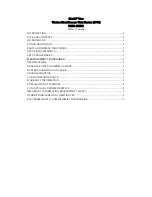
4.1 General cabling guidance
Cable types and length
It is important to use cables of the appropriate type
and length
• Unless otherwise stated use only standard cables
of the correct type, supplied by Raymarine.
• Ensure that any non-Raymarine cables are of the
correct quality and gauge. For example, longer
power cable runs may require larger wire gauges
to minimize voltage drop along the run.
Routing cables
Cables must be routed correctly, to maximize
performance and prolong cable life.
• Do NOT bend cables excessively. Wherever
possible, ensure a minimum bend diameter of 200
mm (8 in) / minimum bend radius of 100 mm (4 in).
100 mm (4 in)
200 mm (8 in)
• Protect all cables from physical damage and
exposure to heat. Use trunking or conduit where
possible. Do NOT run cables through bilges or
doorways, or close to moving or hot objects.
• Secure cables in place using tie-wraps or lacing
twine. Coil any extra cable and tie it out of the way.
• Where a cable passes through an exposed
bulkhead or deckhead, use a suitable watertight
feed-through.
• Do NOT run cables near to engines or fluorescent
lights.
Always route data cables as far away as possible
from:
• other equipment and cables,
• high current carrying ac and dc power lines,
• antennae.
Strain relief
Ensure adequate strain relief is provided. Protect
connectors from strain and ensure they will not pull
out under extreme sea conditions.
Circuit isolation
Appropriate circuit isolation is required for
installations using both AC and DC current:
• Always use isolating transformers or a separate
power-inverter to run PC’s, processors, displays
and other sensitive electronic instruments or
devices.
• Always use an isolating transformer with Weather
FAX audio cables.
• Always use an isolated power supply when using
a 3rd party audio amplifier.
• Always use an RS232/NMEA converter with
optical isolation on the signal lines.
• Always make sure that PC’s or other sensitive
electronic devices have a dedicated power circuit.
Cable shielding
Ensure that all data cables are properly shielded
that the cable shielding is intact (e.g. hasn’t been
scraped off by being squeezed through a tight area).
Cable suppression ferrites
To ensure optimum EMC performance and to comply
with applicable EMC regulations the cables supplied
with this product include suppression ferrites.
Two additional suppression ferrites are included for
use when connecting additional RayNet cables (not
supplied) to the display.
Fit a ferrite to each additional RayNet cable as
shown below:
Cable clip
Cable tie
Ferrite
Cable tie
50 mm
(1.97 in)
Max
D12936-3
If you need to remove a ferrite for any reason, ensure
it is replaced in its original location before using the
product.
46
gS Series
Содержание Raymarine gS 195
Страница 2: ......
Страница 26: ...26 gS Series...
Страница 43: ...D 36 mm 1 4 in E 39 2 mm 1 5 in F 90 mm 3 5 in Planning the installation 43...
Страница 44: ...44 gS Series...
Страница 110: ...110 gS Series...
Страница 146: ...146 gS Series...
Страница 174: ...174 gS Series...
Страница 175: ...Chapter 13 Man Overboard MOB Chapter contents 13 1 Man overboard on page 176 Man Overboard MOB 175...
Страница 178: ...178 gS Series...
Страница 181: ...Chapter 15 Fuel manager Chapter contents 15 1 Fuel manager overview on page 182 Fuel manager 181...
Страница 196: ...196 gS Series...
Страница 218: ...218 gS Series...
Страница 328: ...328 gS Series...
Страница 362: ...362 gS Series...
Страница 411: ...Chapter 31 Technical specification Chapter contents 31 1 Technical specification on page 412 Technical specification 411...
Страница 418: ...418 gS Series...
Страница 438: ...438 gS Series...
Страница 439: ......
Страница 440: ...www raymarine com...
















































